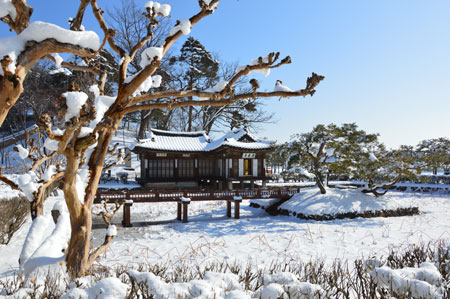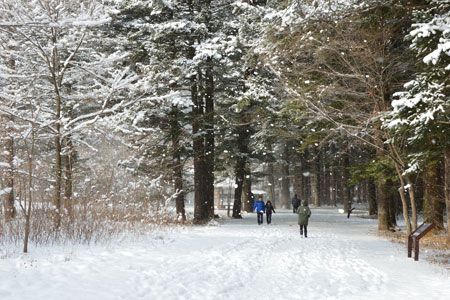Treading on the snow, meditating
Snow makes us feel like we’re in wonderland.
The fluffy white dazzles us by magically descending onto earth from a place we would like to imagine as heaven.
Somehow we feel like being purified when looking at the snow _ something that has not been stained by human presence or pollution.
This picture-like scene cannot often be seen in the metropolitan region, but just a few hours’ drive from Seoul, it will be spread out right in front of you.
When you see that scenery, perhaps only seen in photos before, stretching out before you, not many are be able to describe it articulately.
Sometimes, a single photo can take our breath away. But the real scene makes us solemn.
Woljeong Temple
There are several trails here that showcase the snowy vista in all its glory.
Of those, the fir tree forest surrounding the entrance to Woljeong Temple on Mt. Odae in PyeongChang, Gangwon Province, is mesmerizingly beautiful.
To see the snow carpeting the forest, get out of your vehicle when you see a colorful wooden gate. If you drive past the gate, you may end up directly in the parking lot next to the temple, missing out on the great scenery.
The fir tree forest in front of the temple is an often-visited site for photographers or those who like taking pictures because photos taken there have a postcard like perfection.
A walk to the temple along the pathway takes about 20 minutes, but up to an hour if you stop at several points to take pictures. Stopping is worthwhile because the scenery is more beautiful than that which the temple provides.

A view of a traditional house, or hanok, at Seongyojang in Gangneung, Gangwon Province. / Korea Times photos by Yun Suh-young
The pathway is a great meditating place for monks in the temple as well as visitors walking along it. Monks at Woljeong are known to bow when walking back and forth along the path as part of their spiritual training.
The mystic pathway is more than a thousand years old. The temple was built in A.D. 643 during the reign of Queen Seonduk who ruled the Silla Kingdom (57 B.C.- A.D. 935) until A.D. 647.
At the temple, visitors can experience making lotus flower lanterns with thin craft paper. After finishing the lanterns, temple officials will light them for you to watch them glow in the dark. Visitors can choose to leave the lanterns at the temple or take them home.
The temple also offers a “templestay” program which visitors can experience for several days. The program includes participating in Buddhist ceremonies, making 108 prayer beads, and walking in the fir tree forest. There is a one-night, two-day program specifically for foreign visitors.
For more information, visit www.woljeongsa.org or call 033-339-6800.
Seongyojang
Another place to see snow-coated scenery is Seongyojang in Gangneung, Gangwon Province, which is a residential area preserving traditional Korean houses, or “hanok.”
Seongyojang is a little further away from PyeongChang, near Gyeongpo Beach on the eastern coast.
The area was named because the boats on the lake in front of Seongyojang acted like bridges connecting it to other localities. “Seon” means boat in Chinese characters, “gyo” means bridge and “jang” means place.
Seongyojang has been populated by the descendents of the original house owners for over 300 years. You may actually meet the current owner or the master of the house while strolling around the site.
A cultural guide explains the history of the place as well as entertains with interesting stories related to the houses, and is helpful in providing an understanding of the resident culture of the past.
For instance, according to a tale, houses built on sites where animals used to build their habitat were known to be places where people could become rich. Apparently, Seongyojang was built on a land where weasels used to live and the families who lived there were the richest households in the region.
There are four large buildings at Seongyojang. The houses are didactic in the sense that visitors can learn how wise the forefathers who lived there were with regard to architecture and the usage of buildings.
The place is quite famous already due to frequent exposure in the media. It was the filming location for TV dramas such as “Palace,” “Hwangjini,” and “The Painter of Wind” which were extremely popular. It was also where the movie “Sikgaek” was filmed.
A residential stay program is available with prices ranging from 50,000 to 200,000 per room depending on the size of the room and the quality of the building it is in. An entire hanok building can also be rented.
For more information, visit http://www.knsgj.net or call 033-646-3270.
Ojukheon
Another must-visit place in the region is Ojukheon which is about 10 minutes away from Seongyojang by car.
Ojukheon is the house where Yulgok Lee-Lee, a famous Confucian scholar during the Joseon Kingdom (1392-1910) was born. His likeness is printed on the 5,000 won bill.
Lee-Lee was known to be a genius as he passed the national exam at the age of 13. Sixteen years later, he was placed first in nine of the “gwageo” he took. Gwageo is the highest-level state examination to recruit civil servants during the Goryeo (918-1392) and Joseon kingdoms.
His mother, Sin Saimdang, is another famous figure who is featured on the 50,000 won bill. Lee-Lee and Saimdang are legendary in Korean history. Saimdang is known as the first publicly recognized woman painter in Korea, who was also talented in writing poems, calligraphy and embroidery.
The name Ojukheon comes from the Chinese characters “ojuk” which means black bamboo. Ojuk was the pseudonym of Saimdang’s brother who owned the house.
There is a museum next to Ojukheon for visitors to better understand the life of Lee-Lee and his family history.
For more information, visit https://ojukheon.gangneung.go.kr or call 033-660-3301. <The Korea Times/Yun Suh-young>




















































